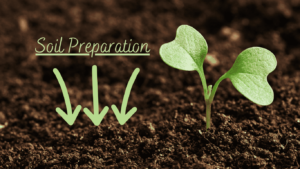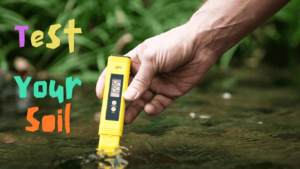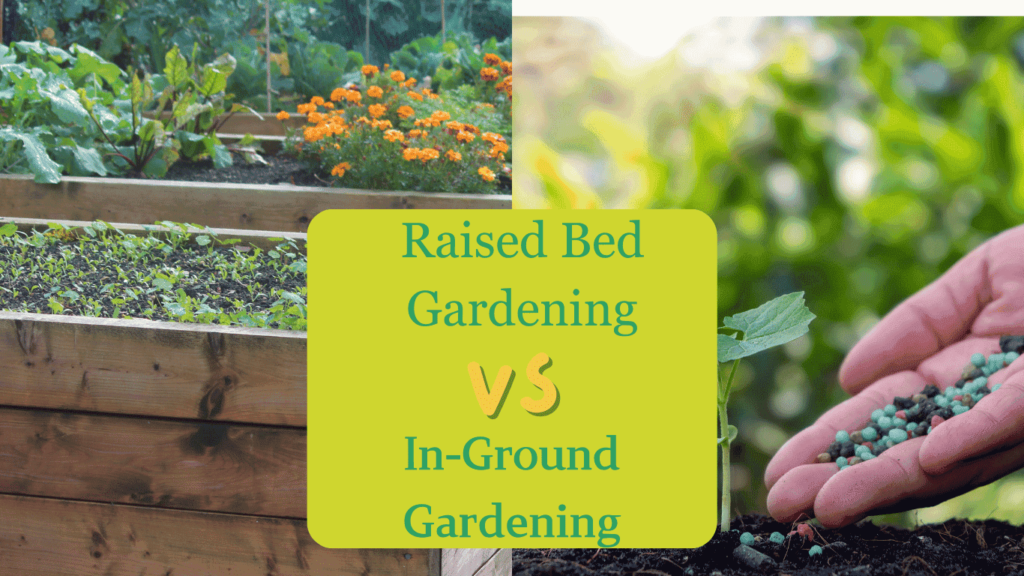The preparation of soil for gardening is crucial as it directly impacts the health and growth of your plants.
When you prepare your soil, you enhance its structure, making soils perfect to access nutrients and retain water without becoming waterlogged.
A proper soil preparation will also ensure that nutrients are present in sufficient amounts, which helps in better drainage and can also help maintain the pH levels.
If you don’t do the soil preparation step, the plants could be struggling with low growth and less yield. Plus, it will be more prone to diseases. This could ultimately cost you your time, energy, and money in gardening.
Different types of soil that you can plant to garden

There are different types of soil that affect the way your plants develop. Here’s a quick overview:
Sandy Soil
It’s Light, drains fast, and gets warm quickly. However, it can’t absorb nutrients very well. It’s ideal for plants that aren’t fond of roots with too much water, like Lavender, Rosemary, etc.
However, you might need to add some organic matter to increase the amount of nutrients.
Clay Soil
It is heavy, slow-draining, and compacted quickly. It’s rich in nutrients; however, it requires improvement. You can use organic matter to improve drainage. It is ideal for growing vegetables such as broccoli, cabbage leaves, leafy greens, etc.
Loamy Soil
This one is my personal favorite because it’s ideal soil for the majority of plants. It’s a blend of clay, sand, and silt.
Loamy soil offers excellent drainage, water retention, and nutrients. If you can find the loamy, you can grow flowers, vegetables, and fruit.
This is why I suggest loamy soil to you. It won’t be wrong to say it’s an all-rounder that can help you grow anything, be it vegetables, fruits, flowers, indoor or outdoor plants, etc.
Silty Soil
It’s smooth and full of nutrients. It could be easily soiled by water. Similar to clay, you’ve to add organic matter in order to improve drainage.
What are the main soil elements that need to be present when preparing soil for gardening?
Healthy soil is made of many components; therefore, when you’re making soil for gardening, you want to make sure that your soil is enriched with these elements:
Minerals: Majority of soil and are composed of sand, silt and clay. They impact soil texture and retention of water.
Organic Matter: This includes decayed leaves, plants, animals, and other organic matter. It is essential for providing nutrients and enhancing soil structure and the growth of your plants.
Air and water: Healthy soil has air pockets that provide oxygen, which is what roots require, and a balanced amount of moisture. A lot of water can cause root damage; insufficient water makes it difficult for plants to absorb nutrients.
You can see many farmers digging and tilling their fields before planting; that’s because they want to add more air and make it lose and contain air.
Understand soil pH for better plant growth

The pH of the soil affects the availability of nutrients to plants:
PH is important because if the soil is acidic or too alkaline, certain nutrients are unavailable for plants, which will limit your plant’s growth. That’s why you need to test and adjust pH, which will ensure that plants absorb nutrients in a timely manner.
Ideal pH ranges for:
Vegetables: They thrive in soil that is slightly acidic and has a pH range of nearly 6.0 to 7.0.
Flower: The pH of the flowers varies depending on the type of flower; however, most perform best in the range of 6.0 to 7.5.
Fruits: Typically, they prefer an acidity between 5.5 to 6.5.
It is important to know about the soil’s composition, types, and pH so that you can make an ideal soil for your garden.
Soil Testing and How to Collect a Soil Sample
Testing soil is crucial, and there are two methods to conduct it. Firstly, let’s understand the methods to collect soil samples:
How to Collect a Soil Sample
Select the Testing Spots: Pick several areas inside your backyard (Where you want to plant a garden) (about 5-10). This will give you an exact representation of your overall soil.
Dig an area: At each location, you will need to dig 6-8 inches into the soil (that’s the normal soil’s root zone). Take a small amount of the soil in each dig.
Mix the soil and dry it: Put all of the samples in a container, mix well, and then let the soil air dry for 24 hours.
Testing: Make use of the sample to conduct tests, whether at home or by sending it to a professional lab.
DIY Home Testing Kits vs. Professional Testing
Here are two methods to test soil:
Home Testing Kits:
Pros: Quick, convenient, and cost-effective. The kits typically analyze for pH and nitrogen, phosphorus, and potassium.
Pros: They may have a lower accuracy and can be specific as professional tests. DIY home kits often do not provide information on micronutrients or soil modifications required, but they may provide general information like the amount of nitrogen, phosphorus, and potassium.
It’s a good choice for beginners who want to know about some basics before gardening, like the amount of nitrogen, phosphorus, and potassium.
Professional Soil Testing:
Pros: Provides extremely precise and thorough reports that include pH, macronutrients, micronutrients, and organic matter, as well as suggestions for improving soil.
Cons: it’s a little expensive and takes a long time (you have to send soil samples and then patiently wait for the results).
Ideal for: People who are starting larger gardens, attempting to grow particular crops, or need any specific advice to improve the soil.
Which soil testing option is better for you?
If you’re starting out and looking for a good understanding of the soil’s pH and the levels of nutrients, a DIY test kit could be enough.
But, if you want plants that are demanding (like fruit or specific vegetables) or want to improve the performance of your garden. Then, I’d suggest you look for professional testing that will give you a specific recommendation for gardening based on your soil conditions.
Improve Soil Structure
Improving the structure of your soil is crucial for establishing strong, healthy plants. You can observe the soil’s structure in terms of how loose, dense, or porous it is.
When your soil has a better structure, it will help water and air to absorb perfectly, which is really good for gardening.
On the other hand, when the structure isn’t good, for example, if the soil is too tight, water can’t reach the roots. Besides this, it can also cause nutrient deficiency.
If you want to improve your soil structure, you can add some organic matter, such as compost, which can help you loosen the soil. Besides this, you can also try other methods like aeration.
Enhancing Soil Fertility
The key nutrients most plants need are nitrogen (N), phosphorus (P), and potassium (K). These are often referred to as the “big three.”
Vegetables, fruits, and flowers all thrive when they have access to adequate levels of these three essential nutrients.
Some great organic options to boost soil fertility include:
Compost: This nutrient-rich material improves soil structure and provides a slow release of N-P-K as it breaks down.
Bone meal: High in phosphorus, which aids root development and flowering.
Fish emulsion: Liquid fertilizer that’s high in nitrogen to promote lush green growth.
Aged manure: Another excellent source of NPK plus beneficial microbes.
However, I’d still suggest you test your soil first so you know exactly what nutrients it’s lacking. After that, you can amend accordingly, whether that’s mixing in compost, topping with a layer of manure, or using a targeted organic fertilizer.
With a little care, you’ll have nutrient-dense soil that will give your veggies, fruits, and flowers the best place they need to thrive.
Mulching for Soil Health
When you’re preparing your soil for gardening, adding a layer of organic mulch is a fantastic idea. Mulch acts like a protective blanket for your soil, providing all sorts of advantages:
It helps retain moisture, so you’ll need to water less frequently.
As the mulch decomposes, it adds nutrient-rich organic matter to the soil.
It suppresses weed growth, cutting down on pesky weeds competing with your plants.
Mulch insulates the soil, keeping it cooler in summer and warmer in winter.
Sustainable Soil Practices
When you’re preparing your soil for gardening, here are some key sustainable practices to keep in mind:
Minimize tilling/turning the soil: Most of the time, disturbance can disrupt the delicate soil structure and microbial life; that’s why you should avoid too much tilling. Opt for gentle techniques like broad forking instead.
Incorporate organic matter regularly: You can add compost, aged manure, or other plant-based materials that feed the soil and improve nutrient cycling.
Rotate your crops: This prevents the depletion of specific nutrients and breaks pest/disease cycles.
Use cover crops: Planting things like clover or rye between growing seasons can help prevent erosion and replenish the soil.
Avoid synthetic fertilizers: you can stick to natural, slow-release options like rock dust or bone meal to nourish plants without harming the soil ecology.
Common Soil Preparation Mistakes to Avoid
There are many mistakes that people make while preparing soil or even when they have a garden.
Over-fertilizing is the first mistake. It’s understandable to give your plants a nutrient boost, but too much food can actually harm your soil and plants.
That’s why you want to stick to the recommended amounts on organic fertilizer packages and get a soil test to know exactly what nutrients your garden beds need.
Another pitfall is ignoring soil pH. The acidity or alkalinity of your soil greatly impacts nutrient availability and plant growth.
Besides this, so many gardeners neglect this crucial component. Adding compost, aged manure, or other carbon-rich materials improves soil structure, water-holding capacity, and the population of beneficial microbes.
Conclusion
When you want to prepare soil for vegetables, fruits, flowers, or any other gardening, you first should focus on soil fertility and structure.
Nutrient-rich organic matter like compost or aged manure. This not only provides a balanced supply of nutrients for your plants but also improves drainage, aeration, and water-holding capacity.
So, you can pair this with sustainable practices like minimal tilling, cover cropping, and avoiding synthetic fertilizers.
Lastly, I’d suggest that Investing a bit of time upfront to prepare your soil properly is the best way to set your garden up for long-term success.
What is the best way to prep soil for planting?
Add 2-4 inches of nutrient-rich organic matter like compost or aged manure, then gently mix it into the top 6-8 inches of soil.
This will improve soil structure, drainage, and fertility. Besides this, you want to avoid excessive tilling, which can damage beneficial microbes.
Finally, top the soil with a 2-4 inch layer of mulch, like wood chips or leaves, to retain moisture and suppress weeds.
These are some simple steps that can help you create a thriving foundation for your vegetable garden, fruit trees, or flower beds to flourish.
Should I soak the soil before planting?
Yes! When it comes to preparing your soil before planting, you can consider soaking a day or two beforehand.
Soaking soil will help fully moisten the soil and ensure your seeds have the optimal moisture levels to get established.
You just want to make sure the soil isn’t staying overly saturated – you want it damp but not waterlogged.
What do farmers do to the soil before planting?
They prefer loosening the soil in order to let it aerate and include any amendments, such as compost. Sometimes, they test the soil to find out the nutrients it’s missing; then, they add specific organic fertilizers that enrich the soil.
Additionally, some farmers cover the soil using mulch or cover crops that help retain moisture and reduce herbicides.

